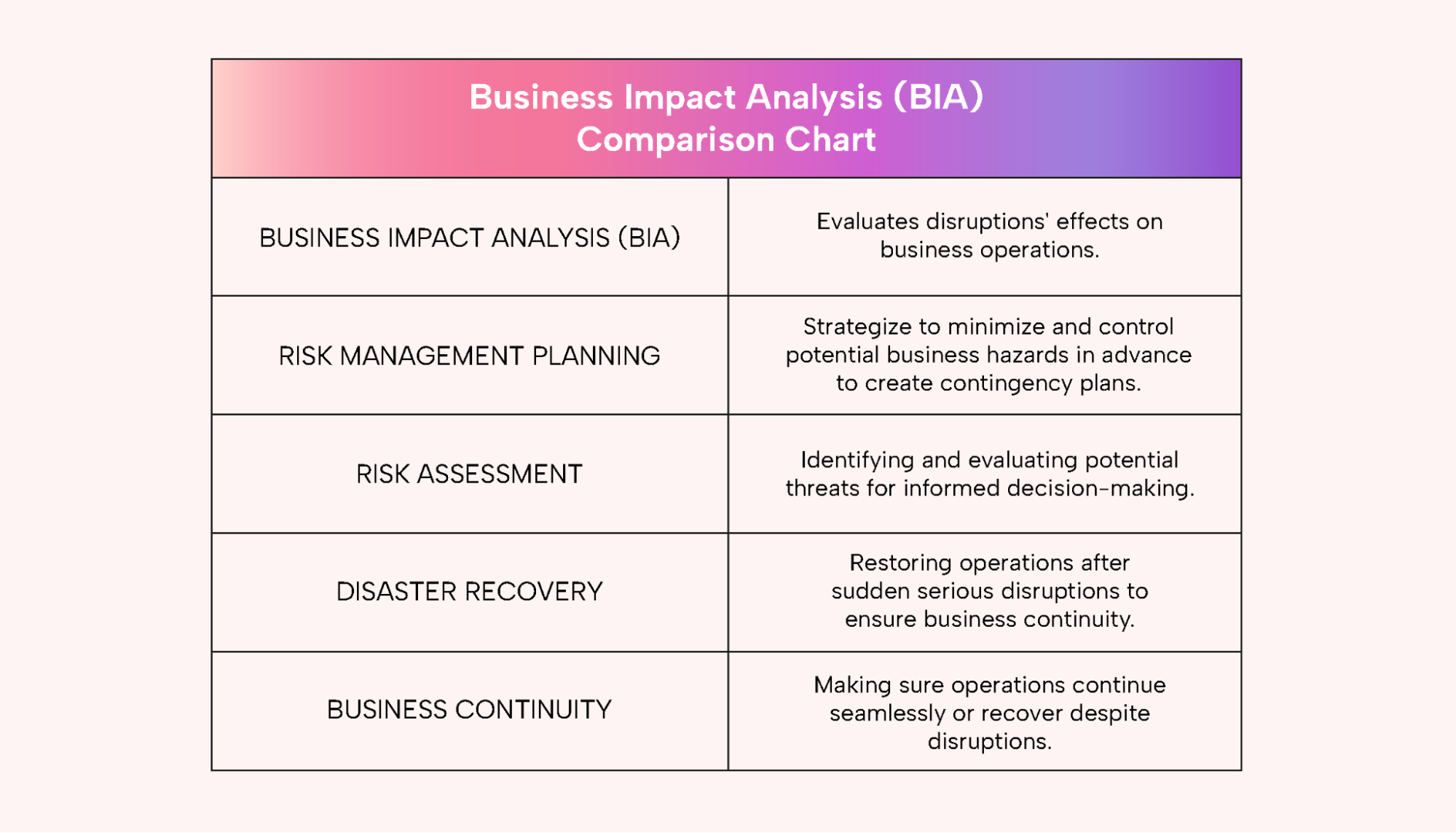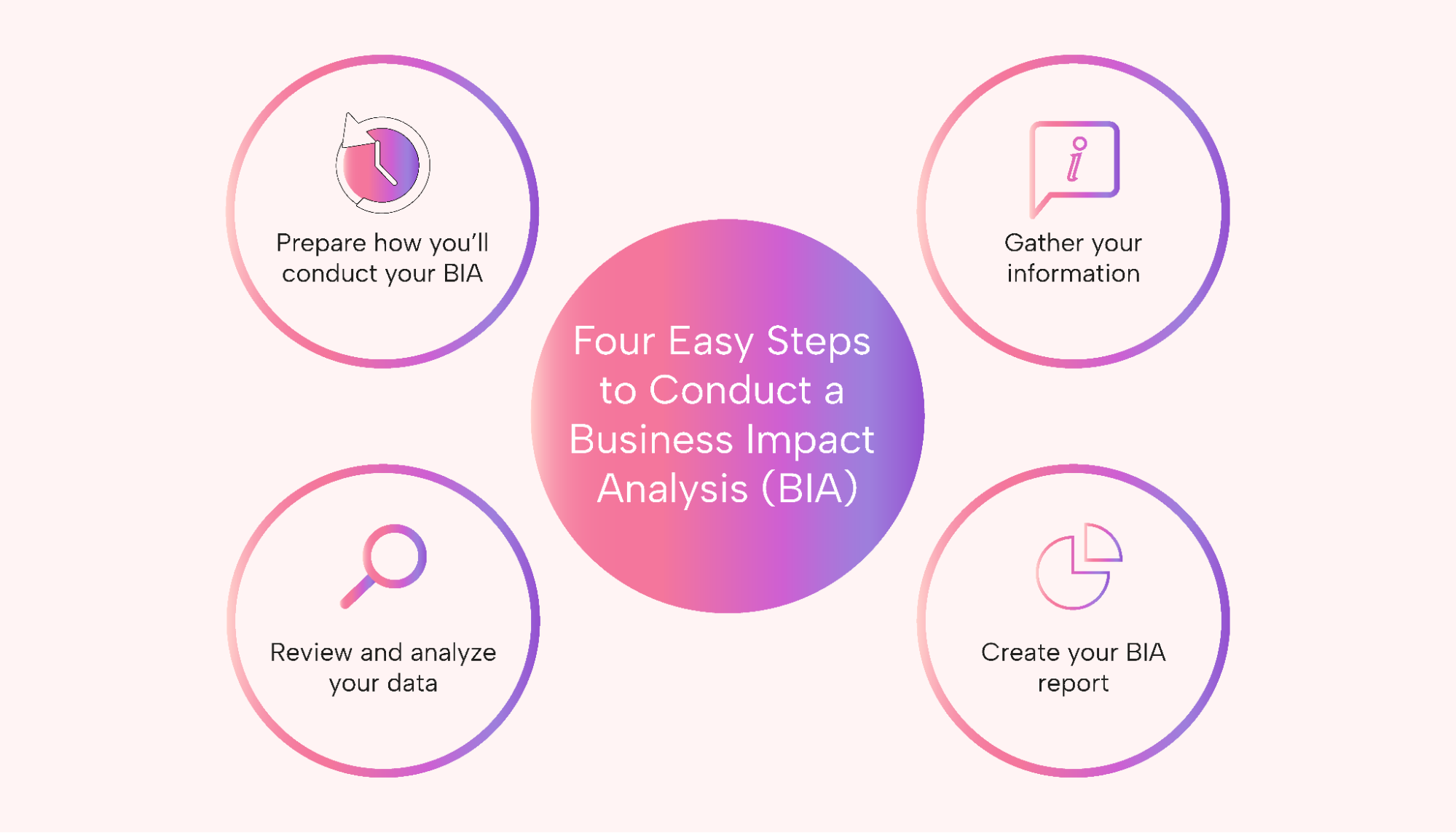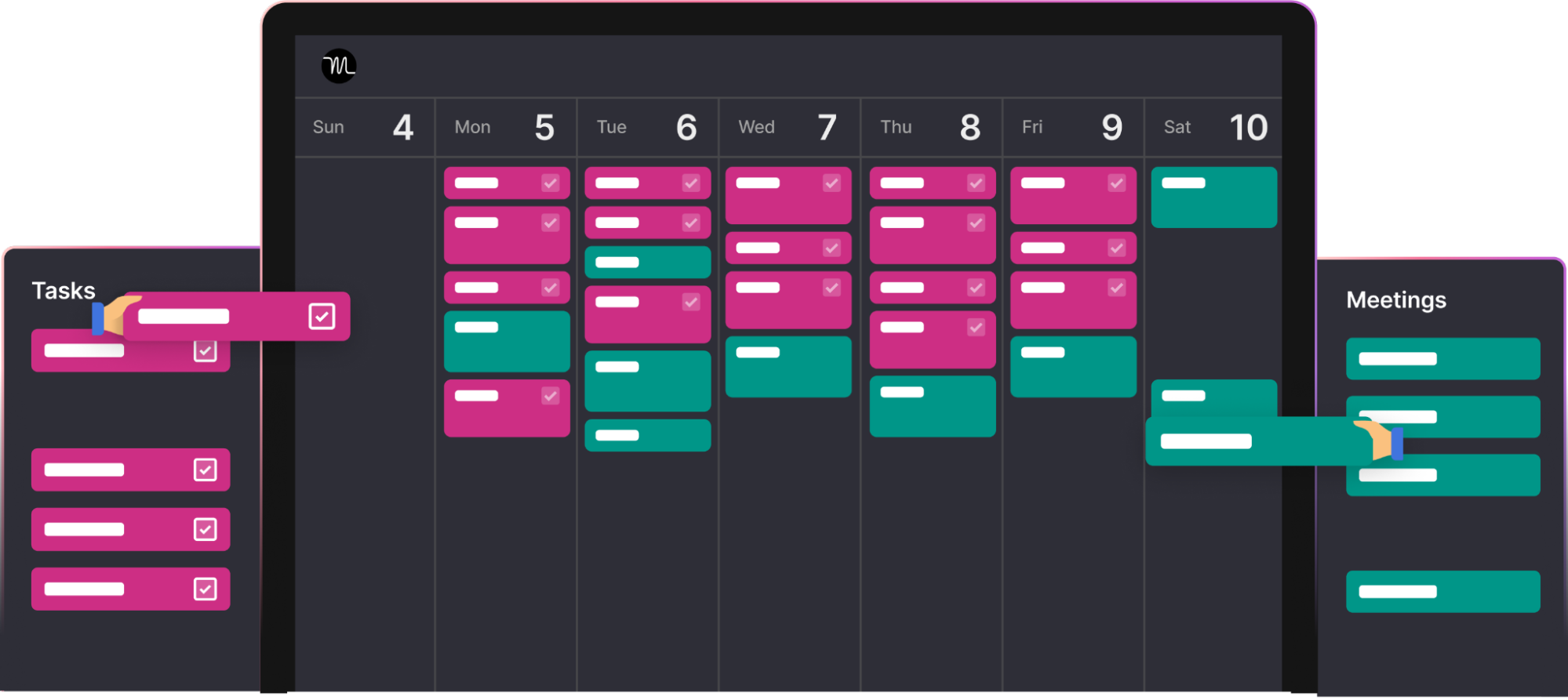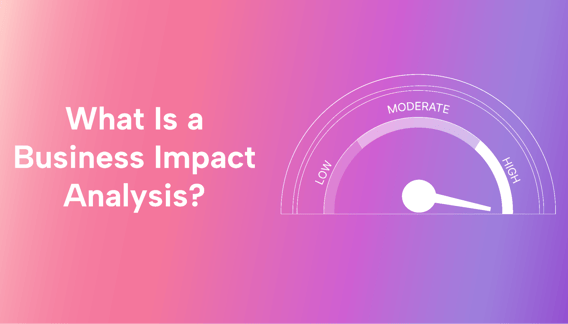Running a business is a rewarding journey, but it’s no walk in the park. Unexpected bumps in the road and market shifts can throw even the most seasoned business owner off track. This is where business impact analysis (BIA) comes in.
In this beginner-friendly guide, we’ll break down what BIA is all about and how it can help you anticipate risks, make smart plans, and keep your business running smoothly.
Whether you’re just starting or looking to fine-tune your business strategy, this guide will give you a straightforward overview of BIA and show you how to use it to protect and grow your business.
What is business impact analysis?
Business impact analysis (BIA) is a practical tool that helps you understand the potential consequences of disruptions to your business, like a cyber attack, fire, or flood. A BIA aims to identify and prioritize critical business processes, systems, and resources. Then, assess the potential consequences of disruptions to any of these in a risk event.
What should be delivered by a BIA?
A BIA is a vital building block of every business continuity management (BCM) program. Gartner defines the three key outcomes it should deliver:
- An enterprise-agreed set of critical business functions, supporting infrastructure and applications, and other dependencies
- A prioritized list, by time frame, of critical business functions for recovery
- An understanding of what the downtime impacts on your business if operations are not available over some time
Your BIA should be done first if you’re just starting your risk-planning journey. In risk management planning, you will identify potential risks to your business and make plans to mitigate these. However, your BIA sets the framework for:
- How you will manage risks in your business
- Disaster recovery and the processes you’ll implement during a risk event
- Business continuity planning and how you’ll make sure your business doesn’t lose traction
BIA helps you correctly analyze these risks and estimate the likely impact. Getting this right as part of your BIA is essential so your business continuity, disaster recovery, and contingency plans have the right foundation.
The benefits of BIA
By assessing your critical business functions, resources, and dependencies, BIA helps you:
- Identify vulnerabilities: Pinpoint weak points in your operations that could lead to downtime or financial loss in the case of a disaster event.
- Prioritize: Determine which functions will need immediate attention during a crisis to minimize the impact on your operations.
- Plan effectively: Develop comprehensive strategies to maintain essential operations and recover swiftly so you don’t have to scramble for the next steps while you’re under pressure.
- Allocate resources wisely: Make informed decisions about resource allocation for risk management. Which projects would be immediately stopped? Which would continue?
- Enhance resilience: Strengthen your business’s ability to weather unexpected challenges and ensure continuity by looking at more agile work methods.
We know it can be scary to think about your business's risks. But, it is much more stressful to face these things for the first time when a risk event occurs. As the scouts say, be prepared.
Business impact analysis vs. risk management planning principles
While they might work together to improve your risk management and make up part of your risk management planning, BIA and risk management in your business aren’t the same.
 |
What does risk management include?
Risk management planning:
- Involves broader identification and evaluation of various risks
- Develops comprehensive strategies to mitigate or eliminate these risks
- It encompasses a wider range of potential threats beyond operational disruptions
- It aims to prevent risks from occurring or minimize their impact
How does your BIA inform your risk management?
BIA informs your risk management by:
- Evaluating specific consequences of disruptions to critical business functions
- Prioritizing essential functions for effective continuity planning
- Guiding resource allocation and recovery strategies based on potential impact
- Focusing on understanding operational vulnerabilities and their potential outcomes
Your BIA might inform your planned responses in your risk management plan, but it is not done instead of your other risk planning activities. Risk management can be done better because you performed a detailed BIA.
BIA vs. risk assessment
As part of risk management, the purpose of risk assessment is to identify and prepare for specific threats that may arise and assess the likelihood and severity of the impact for each. In other words, what are the potential causes of disruptions, how likely are they to happen, and how bad would they be?
A BIA aims to define the consequences of disruption of a business process or function, develop recovery approaches for each, and establish clear priorities for recovery of business processes and procedures when threats do occur.
So, while they aren’t the same thing, they are complementary.
What does a risk assessment include?
A risk assessment is a process that helps you identify and understand potential risks and challenges that could affect your business. It looks at the chance of natural disasters or cyber threats or safety hazards happening and how serious their impact could be. The risk assessment prepares you to devise plans to reduce or remove these risks. It's like creating a safety net for your business. Doing a risk assessment builds a strong base for managing risks effectively and keeping your business safe.
How your BIA informs risk assessment:
A business impact analysis (BIA) helps you see the business impact if something goes wrong and one of the critical parts of your business suddenly stops working. It looks at how problems might affect important operations, like how your business functions, revenue, and your customers' happiness. By understanding these possible problems, you can make a plan to protect or restore the most critical parts of your business. The BIA is like a map that guides you in ensuring everything keeps working or is restored quickly, even when there are bumps in the road.
BIA vs. disaster recovery
What does disaster recovery planning involve?
Disaster recovery planning is like having a safety net for your business's digital assets. It's all about ensuring your business keeps running even when things go wrong. If your computer systems crash or there's a glitch or a flood, your disaster recovery plan is there to help you fix the problems quickly. This means returning your important data, ensuring software and computers work again, and bringing your business functions back to normal. This process helps your business keep running smoothly and quickly gets things back on track after a hiccup.
Imagine if a major disaster like a significant storm strikes. Some businesses, especially those in disaster-prone areas, have a “twin” or failover location in an area not vulnerable to the same hazards. Disaster recovery planning helps you have processes in place to be able to set up shop in a different location if necessary. Think of it as a safety net for your business, ready to catch you when things get tough.
How BIA informs your disaster recovery plan:
By doing your BIA before you complete your disaster recovery plan, you will have already evaluated the impact of disruptions on critical functions and processes. Your BIA will guide how you allocate your resources for effective recovery. It also addresses broader implications beyond just making sure your IT systems are going to be able to be up and running quickly after a disaster event. It also focuses on maintaining essential operations during and after disruptions, so your disaster recovery plan will have step-by-step contingencies to keep your business online.
BIA vs. business continuity planning
Where BIA identifies the impact of disruptions on critical business functions, it also informs how you will plan to continue your business following an incident.
Continuity Planning:
Where disaster recovery focuses on how you will regain operations immediately after a disaster event, such as a flood or cyber attack, continuity planning looks at how your business will continue to run beyond those first crucial moments. Your BIA informs your continuity planning because of it:
- It encompasses a broader approach to maintaining business operations
- Involves comprehensive strategies to ensure ongoing business activities
- Includes various aspects like communication, personnel, facilities, and technology
- Aims to sustain overall business operations during and after disruptions
While all this terminology might seem similar, the distinctions are important. For a greater understanding of what are considered key business risks around the world, check out the Allianz Global Corporate & Specialty (AGCS) annual survey.
But enough about that. How do you conduct a BIA?
Conduct a BIA in four easy steps
When it comes to creating a BIA, there are four easy steps you can follow:
 |
1. Prepare how you’ll conduct your BIA
How you plan to complete your BIA is as vital as actually conducting your BIA. To create the best possible BIA:
- Define the scope and objectives of your BIA process: What do you want to cover, and what will it include?
- Identify key stakeholders and choose a BIA team lead: Who will be involved in creating the plan? Whose insights and skills do you need to create the best possible BIA?
- Establish a timeline and allocate necessary resources: How long will you need to complete the BIA, and what will you need to do it correctly?
- Define the methodology and tools you'll use for data collection: Will you interview key knowledge holders? Will you review your competitors' businesses and events that have impacted them? Will you bring in an outside consultant? Where will you store the BIA and relevant recovery plans? Get a good understanding of where all of this data will live and how you will get it. You’ll need this in the next step.
2. Gather your information
Now that you’ve determined the who, what, how, and where. It’s time to start gathering your data.
- List critical business functions and processes: What are the functions and processes your business MUST retain to be able to continue?
- Identify dependencies, resources, and personnel for each function: What are these processes dependent on? What resources and staff do they need to continue?
- Gather historical data on past disruptions and their impact: What has happened in the past in your business and in the businesses of others?
- Conduct your interviews or surveys with key employees to gather insights: What do they consider to be the greatest risks posed to your workflows and revenue centers? What does your IT manager think? Where are your data vulnerabilities?
3. Review and analyze your data
Once you’ve collected and collated all of your data, take some time to reflect on it before considering your report completed.
- Evaluate the potential consequences of disruptions on each function: Be realistic, no matter how scary it seems. If you lost all your data to a cyberattack, what would happen? What would your clients think? How would your competitors leverage this in their marketing? What are the financial, operational, and reputational impacts? This is the only time in business it really pays to look at the worst-case scenario. It’s not for long, we promise. Then you can switch back to solution mode.
- Prioritize functions based on their criticality and potential impact: When undertaking this exercise, it pays to consider the most critical functions first, then work down the list.
- Identify your recovery time objectives (RTO): Set time goals for each function or process to get back to business after disruptions. If the worst happens, how much time do you have to return online?
- Determine your recovery point objectives (RPO): Set a boundary for acceptable data loss, helping you balance minimizing potential information loss and ensuring your recovery processes are efficient and effective.
4. Create your BIA report
Now it’s time to put your BIA report together:
- Summarize the findings of the analysis for each critical function
- Present the prioritized list of functions and their respective impacts
- Outline recommended strategies and resources needed for recovery
- Provide clear insights to guide continuity planning and risk management efforts
Now that you’ve put in the hours and produced your BIA, it’s time to decide how you’re going to manage it.
BIA and Motion: Automate your risk planning
While risk planning and BIA are vital for your business, it doesn’t have to be overwhelming. Why not automate your risk processes using AI-driven project management software? With Motion, you can:
- Build your BIA in a Google Doc and attach it to a Motion project where everyone can access it.
- Auto-schedule your risk meetings using Motion’s automated Meeting Scheduler.
 |
- Have your contingency plans pre-loaded and assign them to the team using auto-scheduling tools like Motion’s Intelligent Calendar in an event.
- Foster collaboration by moving your projects to a visual tool like Motion’s Kanban boards.
Let Motion manage the admin of your business impact analysis while you focus on your business continuity.
What’s next for your business impact analysis?
You’ve poured all of your energy into building a business you can be proud of. Don’t let anything get in the way of a long and successful future. Planning for risks isn’t the most exciting part of business ownership, but it is critical. Your business can only get stronger when you know how to preempt problems and bounce back from them quickly.
Don’t let business impact analysis and risk management weigh you down. Why not work with a platform that eliminates the manual work of implementing your risk contingencies? Keep your business impact analysis documentation all in one, easy-to-manage place and automate meeting scheduling. Make risk management a breeze in your business. Try Motion free today!





